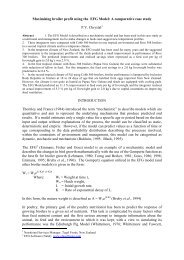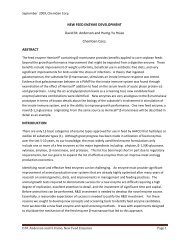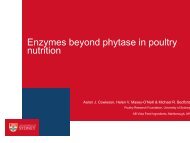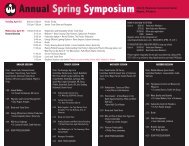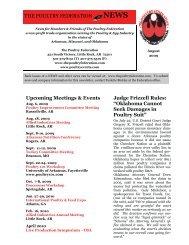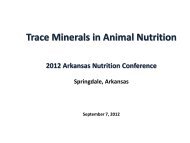Phosphorus Requirements for Broiler Breeder Hens - The Poultry ...
Phosphorus Requirements for Broiler Breeder Hens - The Poultry ...
Phosphorus Requirements for Broiler Breeder Hens - The Poultry ...
Create successful ePaper yourself
Turn your PDF publications into a flip-book with our unique Google optimized e-Paper software.
feed adjustments appropriate <strong>for</strong> the treatment group’s per<strong>for</strong>mance. <strong>The</strong> altered regimenconsisted of feed adjustments appropriate <strong>for</strong> the flock as a whole. Productionper<strong>for</strong>mance, egg quality, breeder skeletal quality, and P retention were monitoredthroughout the experimental period. Plasma samples were collected and assayed <strong>for</strong>PTHrp, tartrate-resistant acid phosphatase (TRAP), and total alkaline phosphatase (totalALP) using colorimetric assays (Lau et al., 1987), and plasma P utilizing a modifiedmethod of the procedure described by Daly and Ertingshausen (1971). Eggs per henhoused were diminished in hens fed the low dietary NPP, and by low pullet target weight(Table 5). <strong>Hens</strong> fed low dietary NPP also had lower egg weights but better shell quality.Mortality was significantly higher in hens fed low dietary NPP and pullets with low BWwere specifically affected, especially during weeks 26-28. <strong>Breeder</strong> tibia relative strengthand ash was also significantly lower in hens fed low dietary NPP %, regardless of thequantitative amount. Hatch of fertile was not impacted by NPP intake or by rearingprogram, but was affected by breeder feeding regimen (p=0.0031). Progeny bone qualitywas not significantly affected by any treatment. However, an initial benefit in 1 dayprogeny weight was observed <strong>for</strong> hens fed 0.4% NPP. Circulating blood PTHrp washigher at 24 weeks of age than at 29 weeks of age (peak) and PTHrp levels were lower inhens reared 20% over target BW (Table 6). Osteoclast activity (TRAP; Figures 1 and 2)and bone mobilization appears to peak 8-12 hours post feeding; followed by a period ofbone re-deposition (total ALP; Figures 1 and 2). Deficiencies in dietary NPP do notappear to exert an effect until nearing peak production; pullet rearing appears to exert agreater effect during the transition into sexual maturity. <strong>Hens</strong> on 0.15% NPP willmobilize less bone than hens on 0.40% NPP, even at peak production. Plasma P readings




